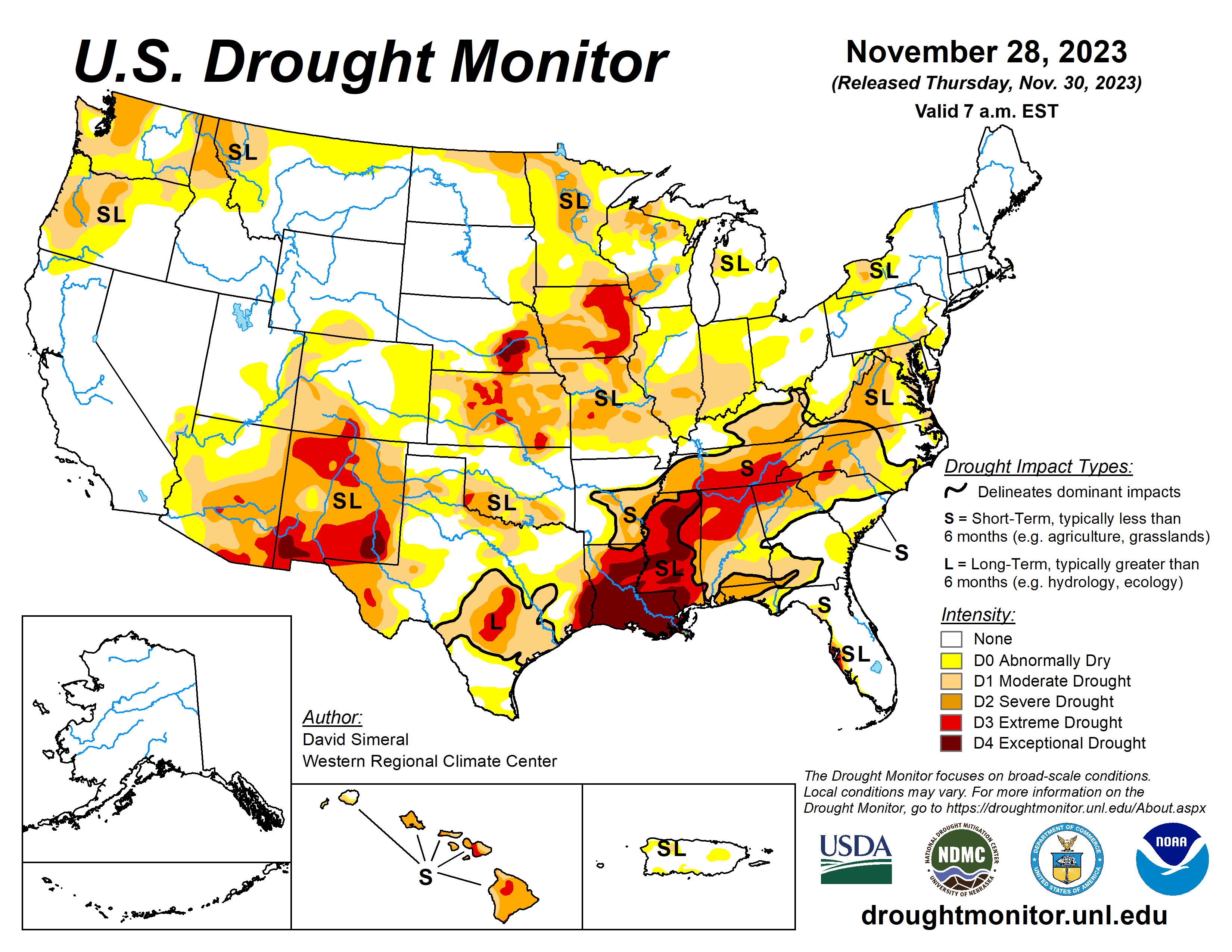Minor expansion of drought regions

This U.S. Drought Monitor saw some minor expansion of drought across areas of the West (Colorado, Idaho, Montana, and Wyoming); and Midwest (Illinois, Indiana and Missouri).
Conditions improved on the map in drought-affected areas of the South (Mississippi, Oklahoma, Tennessee, and Texas); High Plains (Kansas), and the West (Montana and New Mexico).
Cooler-than-normal temperatures prevailed across most of the conterminous U.S. The largest departures observed across areas of the Intermountain West, central and southern Plains, and Texas where temperatures were 6 to 10 degrees Fahrenheit below normal.
Light to heavy snowfall accumulations (2 to 36 inches) were observed across areas of the central and southern Plains, Upper Midwest and the Northeast. The heaviest accumulations fell in the Northeast. The South, Southeast and Mid-Atlantic experienced light to heavy precipitation accumulations of 1 to 4 inches leading to targeted improvements in drought-affected areas on the map.
Moderate to heavy snowfall accumulations were observed in the mountain ranges of central Utah and western Colorado as well as in northern portions of Arizona and New Mexico. The heaviest accumulations (up to 36 inches) were observed in the San Juan Mountains of southwestern Colorado.
The U.S. Drought Monitor is jointly produced by the National Drought Mitigation Center at the University of Nebraska-Lincoln, the U.S. Department of Agriculture and the National Oceanic Atmospheric Administration. (Map courtesy of NDMC.)
South
Precipitation during the past 14-day period led to improvements on the map in isolated areas of Mississippi, Tennessee, Oklahoma, and Texas. Significant precipitation deficits remain across areas of the region including along the Gulf Coast regions of Texas, Louisiana, and Mississippi where 6-month shortfalls range from 8 to 20+ inches.
According to the Nov. 26 U.S Department of Agriculture Weekly Weather and Crop Progress Bulletin, the percentage of topsoil in Louisiana rated short to very short was 72%. Neighboring Mississippi was rated 66% short to very short. Statewide reservoir conditions in Texas were at 68% full, according to Water Data for Texas. The best reservoir conditions were observed in the east Texas (86.6%), north central (84.1%), and upper coast (84.9%) climate regions. The poorest conditions were reported in the South (21%), Edwards Plateau (31.1%), and High Plains (36.9%) regions.
Midwest
Continued dry conditions led to additional expansion of areas of drought in Missouri, Illinois, and Indiana. Various drought indicators, including soil moisture, are showing well below normal levels with values. According to the latest USDA Weekly Weather and Crop Progress Bulletin, the percentage of topsoil rated short to very short is as follows: Iowa, 67%; Missouri, 55%; Illinois, 47%; and Indiana, 42%.
In terms of precipitation, 30-day departures from normal range from 1 to 4 inches across the region with the greatest departures observed in southern Illinois and southeastern Missouri.
High Plains
Some minor improvements were made in areas of Kansas in response to improving conditions during the past 30 to 60 days, including beneficial snowfall observed over the Thanksgiving holiday weekend. Degradations were made in areas of eastern Colorado where drier-than-normal conditions have prevailed during the past 30- to 60-day period.
Conditions on the map remained status quo for the Dakotas. In terms of snowpack conditions, the National Operational Hydrologic Remote Sensing Center reports the upper Midwest region (which includes the Dakotas and eastern portions of Montana) is currently 3.1% covered by snow as compared to 66.3% last month. Average temperatures for the week were below normal (2 to 8 degrees) with the greatest departures observed in the plains of Colorado and Wyoming and Kansas.
West
On the map, improvements were made across areas of New Mexico and Montana. In northern New Mexico, areas of Extreme Drought (D3) were reduced in response to recent precipitation (past 14-day period) including high-elevation snowfall in the Nacimiento and Sangre de Cristo ranges.
In Montana, a mix of improvements and degradations were made on this week’s map, including the removal of an area of Moderate Drought (D1) in north-central Montana where conditions have improved across various metrics during the past 60-day period.
In south-central Colorado, areas of Severe (D2) and Extreme (D3) drought expanded slightly in areas where month-to-date precipitation has been well below normal. The West has gotten off to a slow start in terms of snowpack conditions across the region except for some basins in the southern tier of the region.
Looking ahead
The National Weather Service’s Weather Prediction Center 7-Day Quantitative Precipitation Forecast calls for lesser accumulations (1 to 3 inches liquid) are expected in areas of the Northern Rockies, northern Great Basin, and ranges of the Intermountain West.
Moderate to heavy rainfall accumulations (2 to 5 inches) are forecasted in the South while light accumulations (generally less than an 1 inch) are expected in eastern portions of the southern Plains and lower Midwest.
The NWS Climate Prediction Center’s six- to 10-day outlook calls for a moderate-to-high probability of above-normal temperatures across the western two-thirds of the conterminous U.S. in an area extending from the Midwest to the West Coast.
Sign up for HPJ Insights
Our weekly newsletter delivers the latest news straight to your inbox including breaking news, our exclusive columns and much more.
Below-normal precipitation is expected across much of the southern tier of the conterminous U.S. as well as the central and southern Plains, lower Great Basin, and the central and southern Rockies. Above-normal precipitation is forecasted for the northern Rockies.
David Simeral is with the Western Regional Climate Center.



